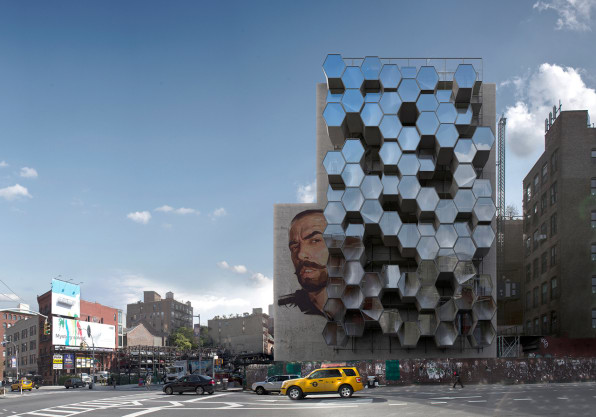
In an example of truly thinking in three dimensions, architects around the globe are beginning to envision housing in a different way. Dubbed “vertical land,” developers are essentially utilizing scaffolding and three-dimensional printing to build homeless shelters on the windowless sides of existing buildings. It’s a controversial and drastic step towards attacking the homeless crises gripping some of the world’s most populated cities.
One of the newest project proposals is called “Homed,” and it’s already been designed and modeled by New York and Oslo-based innovation studio Framlab. The project, if embraced and enacted by the City of New York, would employ hexagonal-shaped pods with a steel and aluminum exterior and an interior composed of 3D-printed polycarbonate wrapped in wood. Each individual pod would then be stacked in honeycomb-style clusters, supported by the type of construction scaffolding that New Yorkers have been used to for decades.
“This is a response to a host of factors that the typical shelter spaces are unable to provide, many of which are crucial for acceptable qualities of life: privacy, safety, individuality, self-esteem, among others,” writes Framlab on a project overview.
The concept is the brainchild of New York-based Norwegian architect Andreas Tjeldflaat, who began investigating the idea after a conversation with a homeless man on the subway about the conditions in city shelters and the man’s choice to live on the streets instead.

“The idea of using vertical space struck me as I was walking through lower Manhattan one afternoon, pondering how the idle vertical land around me might be utilized,” Tjeldflaat said. “Knowing how land is one of the main drivers of cost when building in New York City today, I thought it would be interesting to challenge what ‘land’ might be.”
One interesting design challenge was the intention to give occupants a view of the outside, while simultaneously protecting their privacy inside. When someone enters or leaves a pod, they can lock the door. However, Tjeldflaat designed the front face of the pod from a smart-glass assembly with a layer of thin film diodes. Translucent particles provide privacy from the outside, while the exterior modules can transmit digital content, be it public artwork, civil information or commercial content, which could potentially offset the cost of the pods.
While Framlab is already assessing a potential cost per unit of around $10,000 and talking to potential partners, investors and city constituents, the company recognizes that their concept is just one small step towards a larger goal.

“Homed is a stop-gap solution to alleviate the situation,” said Tjeldflaat. “Then again, the traditional shelter offering is very much a stop-gap solution, as well–and one that comes with a set of challenges. As large groups of people often must share spaces, privacy can be a rare commodity, and many struggle to maintain their dignity because of it. This project’s most significant departure from the current offerings is the fact that these are individual spaces.”
In the United States, homelessness is a major challenge. The U.S. Department of Housing and Urban Development keeps a figure called the “Point in Time” count, which reflects more than 554,000 homeless people across the country, including nearly 200,000 with no access to nightly shelter. But local factors can also come into play in major municipalities.
New York City, similar to many other cities around the globe, has been impacted by its own growth and evolution. Its woes have included a widening housing affordability gap, a steady decline in housing assistance, and the post-1955 disruption of the city’s robust portfolio of single-room occupancy (SRO) units.
Other designers have caught on to the potential of vertical space as well. In San Francisco, home to more than 8,000 homeless people, researchers and designers are taking a broad approach to potential solutions. One vertical solution by housing firm Panoramic Interests is dubbed the “Micropad,” an unconventional prefabricated shelter that is stackable, easy to manufacture, and versatile.

In 2015, British architect James Furzer of Spatial Design Architects proposed an award-winning project called “Homes for the Homeless.” The design involved parasitic pods made of materials similar to a “host” building, providing comfort for those used to “sleeping rough” in London while blending in with the aesthetics of the neighborhood. The project won money from Illinois-based architecture firm Fakro for its “Space for New Visions” competition and raised more on Indiegogo but remains more conceptual than practical.

A design conceptually similar to Homed emerged in Hong Kong earlier this year when studio James Law Cybertecture unveiled a prototype for low-cost, stackable micro homes housed in concrete pipes, designed to fit into gaps between city buildings. The units, called OPod Tube Housing, uses wide concrete water pipes transformed into liveable housing, with doors that can be unlocked via mobile devices. While not specifically designed for the homeless, studio founder James Law thinks the design would appeal to younger residents who can’t afford private housing.
Whether it’s tiny homes, parasite pods or a solution that hasn’t yet emerged, experts seem to agree that an important part of any solution remains: give homes to the homeless.


